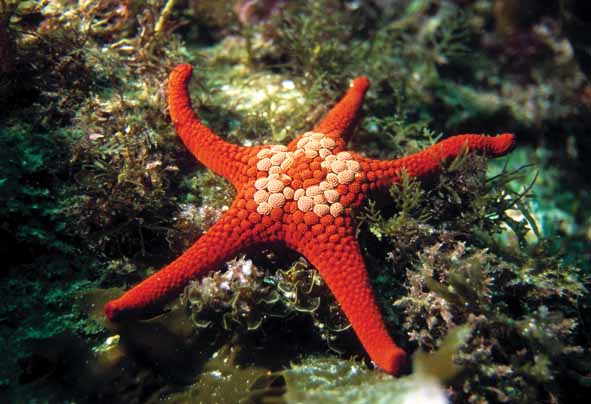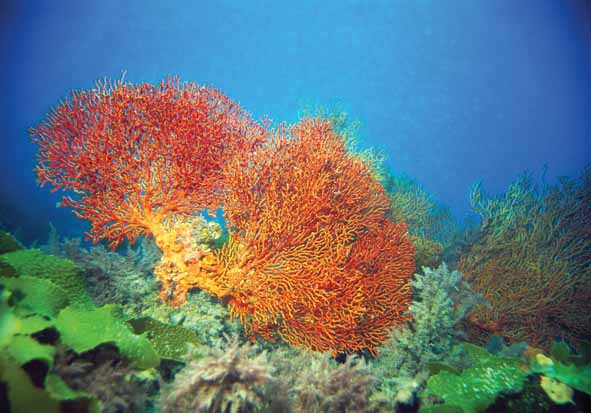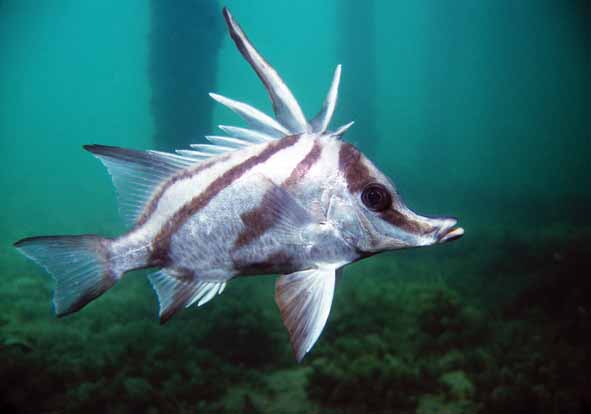
MLSSA
Newsletter
AUGUST 2002
No. 291
Next Meeting
Our next meeting will be held at the Conservation Centre, 120 Wakefield Street on Wednesday August 21st commencing at 7.30pm.
Our speaker will be Heidi Bartram (see note at the end of this Newsletter) who will be tackling the topic of Youth Projects.
We will be continuing the system we tried last month and have the speaker first. Then will come the General meeting business.
If time permits some more slides will be viewed for possible inclusion in the photo Index or the 2004 calendar.
Contents
Dive At Granite Island
Funding For Island Upgrade
Tumby Bay Jetty Dive
2003 MLSSA Calendar
Homeopathy
Our August Guest Speaker
Thank You David!
In response to my appeal for newsletter items in the July edition David has put pen to paper and supplied several articles.
Steve is a regular contributor and Chris and Alex often supply interesting articles.
I ask other members to do the same and every contribution is valued. This is YOUR newsletter and member contributions are to be preferred over those from outside organisations and individuals.
Thanks to Ben Brayford from Granite Island Nature Park, I have now realized one of my diving dreams. On Sunday 23rd June I visited Ben’s ‘office’ at Granite Island. Actually, it’s off of the island. Ben’s office is the "Below Decks Shark Aquarium", a platform moored away from the Screwpile Jetty on the island. I drove my wagon across the causeway to the island with two passengers onboard. They were my dive buddy Peter and my friend David Offord. David is our latest Society member and was on his first Society dive trip. It was good to see that Ian Catt, the Harbour Master, was on the job when he challenged me about having a causeway permit. He found that I was displaying the Marine Life Society permit as required. We were on the Screwpile Jetty by about 10am and started to gear up for a dive. Ben soon arrived with a freshly filled scuba cylinder, saying that he had had to get Chris Fieldhouse of Victor Marine out of bed to start his fun-filled day. Whilst we finished gearing up, Ben rowed a dinghy out to Just Cruisin, the twin-hulled boat used for ferrying passengers out to the aquarium. By the time that he returned in Just Cruisin, we were ready to load our gear on board. We were soon tying up to the platform, with David showing off his skills. Ben was the dive leader for the day and advised us that our first dive would be around the outside of the aquarium so that he could check the cage and windows. The ‘aquarium’ is actually a large mesh cage and we found that the mesh was thick with marine growth such as ascidians. Through the odd bare patch of mesh we could see sharks, fish and rays swimming around inside the cage. It was either fortunate or good planning that David was snorkelling because he was able to hop back on to Just Cruisin and help by taking our scuba gear from us for the exit. Ben tormented us with debate about whether or not we could dive inside the cage with the sharks but he could see that were weren’t going to be put off from realizing our (my) dream. Ben told us that he would go in first but somehow in my eagerness I was first in and Peter followed me. We both waited on Ben and David before descending to the bottom of the cage. Ben had some more work to do on the windows inside the cage and David snorkelled around for a while. Meanwhile Peter and I explored the cage checking out the various sharks and rays. Whilst some other MLSSA members were in Whyalla diving with dangerous man-eating, sex-starved cuttlefish, there we were, diving with several starving sharks. Ben hadn’t bothered to feed them that morning. Perhaps he didn’t want to get them too excited. Peter and I really enjoyed the dozens of Port Jackson Sharks around the cage. Some were quite large. We were occasionally checked out by a large Seven-gilled Shark, Gummy Shark and a 2m Bronze Whaler. It was great to see their long tails pass us by. My biggest surprise came when a large black stingray came straight at us before veering away. On the bottom of the cage we often encountered three large wobbegong sharks laying motionless. The cage was also full of large fish such as sweep and a small school of about six Long-snouted Boarfish which allowed us to get right up close to them. We avoided contacting any of the residents of the cage so as not to upset any of them. By the time that Peter and I had seen enough, Ben had changed into his clothes and was ready to assist us out of the cage. Peter said that he would never forget this day for as long as he lived. I was thinking the same thing myself. We re-boarded Just Cruisin for the return trip to the jetty. Ben had time to ask us about our dive before he had to leave for a dive course (Rescue Diver) in Normanville. We met Paul, the Captain of Just Cruisin, who would be taking tourists out to the aquarium for the rest of the day. We heard that the crew from "Getaway" would be visiting the aquarium the next day to film everything. We almost caught up to Ben on the causeway back to the mainland. We stopped for lunch on the foreshore before making the return trip home. The good news for all those camera snapping members who couldn’t make it on the day is that Ben is happy to have us all down there again another day. Those cuttle-crazy crew are welcome along too.
Steve Reynolds
Funding For Island Upgrade
Whilst on the subject of Granite Island Nature Park, it has been granted $50,000 by the Federal Government. The Regional Tourism Funding Program has allocated $50,000 to upgrade and develop tourism facilities on the island. Some of the funding will go towards the Penguin Interpretive Centre and some will be used to expand eco-tourism experiences on the island. Congratulations to the Nature Park which is a member of our Society.
Steve Reynolds
Jenni and I had a few days R and R at Port Lincoln this week so I took my gear, hoping to get a few dives.
The shore/jetty dive prospects and viz at Whyalla, Cowell, Port Neill and Arno Bay varied from poor to "possibly just o.k. but let’s try the next town".
Finally at Tumby Bay, the last town before Port Lincoln, both the viz and the jetty access looked adequate so in I went, complete with a ‘Seachange’ Shark Shield electronic device kindly loaned to me by Mike Wescombe-Down of the Coastal Waters Dive Club. (I wore this shark repellant on all the three dives on this trip and whether wearing a dry-suit or wetsuit I found it simple to wear, very light and compact. It is a vast improvement on the old POD version and I especially valued the reassurance it provided while diving solo in what was for me new territory, at Tumby Bay at any rate.)
Right under the very convenient entry/exit platform midway along Tumby Bay jetty I almost landed on a very beautiful Leafy Seadragon!
(If you were surprised then I bet the Leafy had a few unprintable thoughts!! - Ed.) This was a good omen as the site turned out to be surprisingly interesting. The water was clear, there was comparatively little rubbish on the bottom, and minimal surge made photography easy. Most of the bottom was heavily carpeted with very healthy seagrass; mainly Posidonia australis, with only a few patches of sand, old pylons/crossbeams and clumps of green and brown algae.
The Leafy hung around a big clump of brown algae, which included scaberia, cystophora and sargassum, whereas only two metres away two Shortsnout (short-headed) Seahorses (Hippocampus breviceps) resided in some Caulerpa obscura.
Well, at least one did - and it was only because its pale brown body was so obvious against the rich green of this algae that I spotted it at all. After taking pictures of this female for some minutes I belatedly discovered its larger male mate resting in more typical cryptic fashion among ‘matching’ brown algae nearby.
This reminded me of an experience by Thierry Laparousaz (Collection Manager, Marine Invertebrates, SA Museum) on our March’02 collecting expedition at Western River Conservation Park, KI with Jim Thiselton, Karen Gowlett-Holmes et al.
Thierry was surprised to see a pair of Shortsnout Seahorses riding in a detached clump of brown algae drifting past as he did his safety stop at 3 metres depth. Luckily for these cute little syngnathids, being true fishes they did not warrant collection, as this was a dedicated marine invertebrates collecting trip!
Now, back to Tumby Bay - what else did I see?
Some lovely little light-green leatheries, species uncertain, foraged over the posidonia and I hope to get an ‘ID’ on these when I collect the slide images this week. (possibly juvenile bridled leatherjackets?) Some very approachable pencil weed whiting displayed an attractive lime-green colouration as evidence of their ability to change colour to suit their background, and a very inquisitive yet typically shy blue rock whiting (Haletta semifasciata) repeatedly slipped surreptitiously beneath the seagrass canopy so as to get in close for a good look at this bubbling, noisy and clumsy monstrosity.
The pylons had a reasonable variety of benthic organisms, but nothing to really excite a veteran jetty diver.
This jetty will live in my mind specifically as a great spot to experience, in comfort and good viz, the remarkable biodiversity of its very healthy, indeed positively luxuriant posidonia seagrass ecosystem.
I was not surprised to learn from the foreshore Port Lincoln dive shop that their instructors often take students to Tumby Bay Jetty.
When I get time, in another Newsletter I will tell you a bit about my following two dives under Port Lincoln Jetty - where I took lots of piccies of amphipods, three species of shrimp, anemones, octopi, ascidia, gobies and . . . . . wait for it . . . . . Pentacta anceps! Yes I found two of these gaudy holothurians, sometimes called the Candy-striped Sea Cucumber, and although they have a well-documented distribution from subtropical W.A. around to western S.A. I hadn't seen them before so I got quite excited.
But, as MLSSA members well know, there's always something new to get the juices flowing under any S.A. jetty.
Oh, and after one of these Port Lincoln dives, who should rock up for a friendly chat but one Barry Davis, a colleague of Mike Wescombe-down from the Coastal Waters Dive Club.
It’s a small world, eh? - especially as he recognised Mike's Shark Shield. Just as well it really was borrowed, not misappropriated! Hmmmm. . . .
David Muirhead
The 2003 MLSSA calendar is now available and features stunning images of South Australian marine life. All pictures were taken in South Australian waters.
(A few are shown below for your delectation)



2003 Calendars
As you can see from the above the 2003 calendar is now available.
They are being released now because many people purchase them for overseas friends and relatives and early posting is needed.
We ask all members to sell a minimum of 30 each (more would be appreciated) at a price of AUS$10 each.
Please contact Philip Hall on (08) 8270 4463 or mobile 0407 39 55 66 to obtain copies.
Homeopathy
Homoeopathy is a therapeutic alternative to conventional medicines. It uses tinctures of plants, animals and minerals to treat specific bodily dysfunctions, emotional trauma and mental illness. The tinctures are made by a long process of serial dilution, at the end of which the remedy is so dilute that there is only a very tiny portion, or sometimes none of the molecules of the original element left in it. However, the energetic ‘fingerprint’ (detectable by modern physics equipment) is enough to treat a patient.
Calcarea ostrearum
Made from the inside of oyster shells, this homoeopathic remedy is especially good for children. It is basically calcium carbonate, so it is especially good for treating faulty bone development, for example if the skull bones (fontanelles) do not grow together rapidly after a baby is born, this remedy can assist in their correct development.
It can also be given for tonsillitis, vertigo and other phobias, and weird bodily discharges.
Murex
This remedy is made from the body of the Murex snails and is especially good for treating women for preventing miscarriages and other problems to do with female genitals.
Sepia
This remedy is made from the ink sac of cuttlefish. It is good for the, nerves and skin and for venous circulation in the female pelvic region. It can also treat poor memory, herpes and ringworm. These homoeopathic remedies can also treat the underlying emotional and/or mental causes of many bodily symptoms. Emotional problems treatable with Sepia include anger, irritability, misery and indifference, especially when they are all present together.
Alex Gaut
Our August Guest Speaker
I have been in Canberra recently for a Youth Roundtable meeting. I got involved in this through an application form that I saw at University. The group is not limited to tertiary students, but is rather open to anyone around Australia between the ages of 15 to 24. There are 6 interest groups within the 50 people, including the environment team, which I am a part of. Each of us has to develop a community project to research and implement, and then make recommendations to the Government in September as to what policies we believe should be followed through. I have narrowed my ideas to two projects.
The first is marine education and conservation camps for both primary and secondary schools. These camps will provide students with an increased appreciation and knowledge of the marine environment, to understand what impact their actions can have, and make them think twice. Fortunately Kingscote Area School (my former school) have said that they would like to trial the camps and, with their support and endorsement, other schools around the state will pick up the initiative. The long-term goal is to have the camps incorporated into the South Australian syllabus as an annual event for as many schools as possible.
My second project is to get a voluntary or partially funded group together on Kangaroo Island to deal with the seagrass loss occurring in Nepean Bay. There is currently a small committee with a minimal amount of funding doing this, so I would like to get support for them and more interested people being involved. Furthermore, seagrass degradation is a big issue in many places throughout South Australia, so the offshoot of this I guess would be to try and establish more support for these areas too, as well as significant government funding and protective policies. Getting organisations and people such as yourself involved would be a great help and I would love to speak with you at some stage and come to one of your meetings. I would also love the chance to be a guest speaker later in the year. We give our presentations to the government in September, so I will talk about what I hope to achieve.
Heidi Bartram